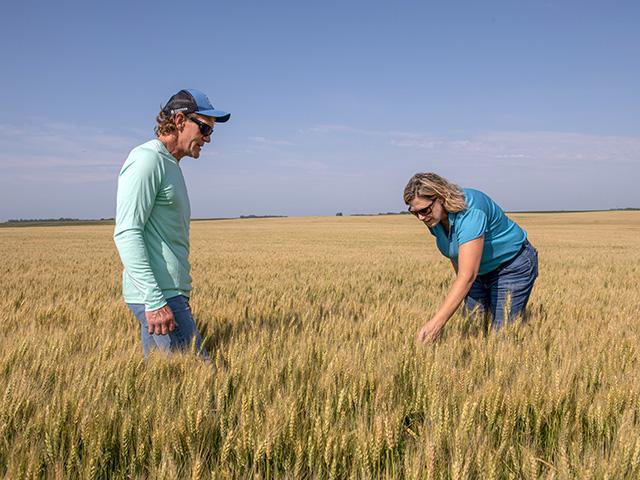Spring Wheat Shows Yield Variability
Day 1 Spring Wheat Tour Estimates 48.1 BPA
MANDAN, N.D. (DTN) -- If Day 1 of the Wheat Quality Council's Spring Wheat and Durum Tour had a theme, it would be crop variability. Yet when the results were tallied from 130 spring wheat fields checked on Tuesday, July 25, the weighted average yield was estimated at 48.1 bushels per acre (bpa), just shy of the 48.9 bpa recorded on Day 1 of last year's tour.
Nearly 60 tour participants in 14 vehicles left Fargo and spread out across southeast and south-central North Dakota to assess the spring wheat crop, estimate potential yield, and note pest and disease pressure. At the end of the day, as the scouting reports from each team were shared, it was evident that North Dakota's growing season had affected the wheat crop on a field-by-field basis.
A seemingly endless winter brought heavy snowfall to much of North Dakota -- as much as 100 inches in some locations. The snow was slow to melt, delaying planting for many growers, only to be followed by a jump into summertime temperatures well above average with little precipitation.
"We went from thinking we weren't going to plant an acre to going wide open in three weeks because we had all that 90-degree weather (in May)," said Mark Olson, a wheat grower who farms near Enderlin, about an hour southeast of Fargo. He noted that in a typical year, he likes to have his wheat in by the end of April. "Our early wheat is very short, and the kernel count is down, too. But the wheat that was planted just two weeks later, it's way better."
Olson's observations of his own wheat mirrored what the tour scouts found. Two fields 10 miles apart could have vastly different estimated yields depending on when the wheat was planted and if it had received rainfall.
P[L1] D[0x0] M[300x250] OOP[F] ADUNIT[] T[]
"You can guess all day long, and it's hard to tell," Olson said. "I think we'll average 50-bushel wheat. There'll be some 30 and 40 to go along with some 60. Our goal is 80 bushels normally."
In the 135 spring wheat fields observed by tour scouts, estimated yields ranged from a low of 19.6 bpa to a high of 117.5 bpa. The scouts also estimated yield in five durum fields that averaged 53.6 bpa.
Overall, pests and disease were estimated to be low with some observation of Fusarium head blight, bacterial leaf streak, wheat stem maggots and grasshoppers.
Based on July 1 conditions, USDA estimated a yield of 45.2 bushels per harvest acre, down 1.0 bushel from 2022. Durum production was forecast at 37.9 bushels per harvested acre, down 2.6 bushels from last year.
On Wednesday, July 26, Day 2 of the wheat tour moves into northwest and north-central North Dakota, ending the day in Devils Lake. The routes will take some of the scouts through Hurdsfield where Jeff Mertz, a past president of the North Dakota Grain Growers Association, farms spring wheat and durum.
"There's the highs and lows, the good, the bad and the ugly," Mertz said of crop conditions in his region of the state. "You get that backyard syndrome, when you're looking out the back door and seeing this field that you know is bad. And it makes you think everything looks like that. But go 10 miles away where they got a rain, and it looks good.
"That's how this crop is going," he said.
DTN Crops Editor Jason Jenkins is participating on this year's tour. Look for more daily updates and final yield estimates on www.dtnpf.com and on Twitter.
Jason Jenkins can be reached at jason.jenkins@dtn.com
Follow him on Twitter @JasonJenkinsDTN
(c) Copyright 2023 DTN, LLC. All rights reserved.






